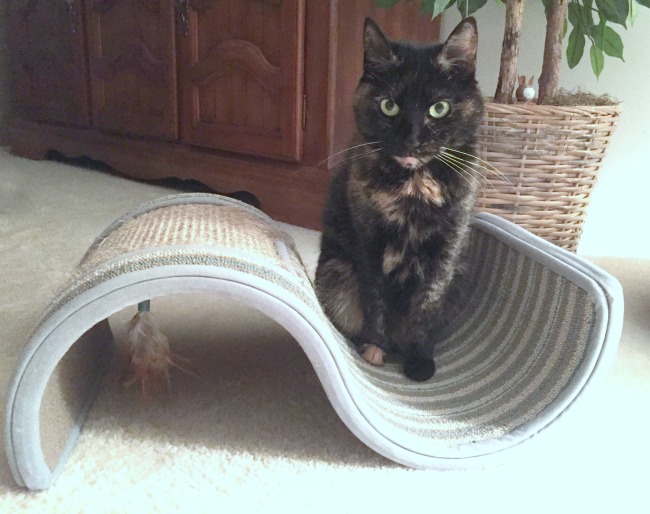
This post contains some affiliate links*
This is the second part in a four part series about my experience during the last four months of Ruby’s life, from diagnosis to caring for her through her illness, to having to let her go. Click here to read part one: Ruby’s Last Journey: The Moment That Changed Everything.
I had been down a similar road before.
My first cat Feebee developed lymphoma at age 15. I elected chemotherapy, and he did pretty well for about seven months. When his cancer came out of remission, my choice was to move to a stronger chemotherapy drug and/or to consider blood transfusions. He declined rapidly before I could even come to a decision, and he died while my vet was on her way to my home to euthanize him.
I cared for Buckley for nine months after she was diagnosed with restrictive cardiomyopathy at the age of (probably) 14. I talk about that experience in detail in my book Buckley’s Story: Lessons from a Feline Master Teacher. She died Thanksgiving weekend of 2008 with the gentle assistance of my veterinarian.
Ruby was only 9 years old. I never expected to lose her so soon.
What is hospice care?
Hospice care, also known as palliative care, involves providing supportive care to cats in the final stages of their lives so that when the time comes, they can pass peacefully. The primary goal is to keep the cat comfortable and free of pain, with a focus on quality of life.
Hospice care should not be considered a last resort. It is not about dying, but rather, about finding ways to help the cat live comfortably with a terminal illness.
The World Health Organization defines palliative care as “an approach that improves the quality of life of patients and their families facing the problems associated with life-threatening illness, through the prevention and relief of suffering by means of early identification and impeccable assessment and treatment of pain and other problems, physical, psychosocial, and spiritual.”
I particularly like the emphasis on psychosocial and spiritual care for the entire family. When a cat becomes terminally ill, it doesn’t just affect the cat, it also affects the cat’s primary human caregiver as well as other family members, both human and feline.
Hospice care is not about giving up. It may actually involve providing more care than pursuing aggressive medical treatment, not less. First and foremost, hospice care is about keeping the patient comfortable. It also takes into account proper nutrition and hydration, and pain management.
The decision to provide hospice care should be made in conjunction with your veterinarian, who needs to become an integral and trusted partner in the process.
In Ruby’s case, this meant weekly visits from Dr. Tasi to assess her health status. These visits were invaluable to me. When you’re the only care giver for a sick cat, you don’t always “see” accurately what’s really going on. While my veterinary background as well as my previous experience of caring for terminally ill cats gave me an edge in terms of knowing what to expect with regard to physical symptoms and how to deal with them, there was still a healthy dose of denial at work throughout the process. It helped to have Dr. Tasi confirm my assessment of Ruby, or occasionally, gently suggest that maybe I was being a little too optimistic. Most of the time, we were in synch when it came to evaluating Ruby’s status.
Nutrition and Hydration
For the first few weeks after diagnosis, Ruby still ate pretty well, but she was losing weight at a much more rapid rate than she should have, given the amount of calories she took in.
I have always weighed my cats once a month. Your cat’s weight can be a good indicator of her health – but only if you keep track of it. Gradual weight loss or gain can be difficult to recognize in cats. Consider that the average cat weighs 10 pounds. Weight loss of only 6% of a cat’s body weight is considered a clinical sign – that’s less than ten ounces. Depending on the size of your cat, visible changes to her weight may be too subtle to notice without actually weighing her.

I started weighing Ruby once a week, but she lost weight so quickly, I didn’t really need the numbers to confirm what I was seeing with my own eyes. At her healthiest, she weighed about 7 pounds. It was alarming how quickly she became bony, and her appearance started to take on that “sick cat” look, with her fur not quite a shiny as it used to be. At the time of her death, she was down to 5 pounds.
In the beginning, Ruby still ate her raw food, but over time, she was less and less interested. I tried a variety of canned foods. Whenever I landed on something she liked, I was relieved – but after a few days, she decided she didn’t want that particular food any longer. There were days when she barely ate anything.
One of the markers I had in my mind for determining when it was time to let her go was if she stopped eating. As a result, meal times became emotionally difficult for me, especially on days when she barely touched her food. On each “bad eating” day, I was afraid that it was the beginning of the end.
A couple of weeks into this process, I changed how I fed her. I had always been meal feeding the girls twice a day. They had to be fed separately. Allegra is a fast eater, while Ruby preferred to take her time. When I fed both of them in the kitchen, Allegra would hone in on Ruby’s meal to “help her finish it” as soon as she was done with hers. Meal time needs to be peaceful for cats, and having me referee was not going to achieve that, so Ruby always ate in the bathroom with the door closed. Whatever she didn’t eat within 20 minutes would get tossed. By the next meal, she would usually catch on and finish. Once she was sick, I couldn’t keep this routine up, given how little she ate at one time.
I started feeding her small meals every two or three hours throughout the day. I only fed the first meal of the day in the bathroom to keep some semblance of a “normal” routine. After that, I fed her in the kitchen. The amount of food she ate per day slowly increased again.
After buying enough canned food to open my own cat food store, trying to find something, anything Ruby would eat consistently, she finally settled on Merrick Kitten Formula. She ate this food with gusto until her very last day. She still needed small portions at one time, but she ate the amount a cat of her formally healthy weight of seven pounds should be eating.
Allegra was surprisingly respectful of this new arrangement. She would watch Ruby eat in the kitchen, but never approached her dish. It probably helped that she didn’t care for the kitten food. Whenever she got a little too curious about Ruby’s frequent meals, I gave her a few treats.
It was heartening to see how much Ruby enjoyed her meals once we landed on the kitten food. Mealtime became a joyful rather than stressful experience again. Sadly, her weight continued to drop. If ever there was confirmation that she had cancer, this was it.
There is a lot of misinformation out there about the proper diet for a cat with kidney disease. Sadly, much of it is perpetuated by veterinarians who should know better. Most of the so-called prescription diets for kidney disease restrict protein, which creates its own set of problems, and isn’t indicated until the final stages of kidney disease. And most of these diets aren’t very palatable.
The most important thing for a cat with kidney disease is that she eats.
What she eats is less important. Ideally, you should choose foods that are low in phosphorus, or add a phosphorus binder to her meals. I used Phos Rx for a few days, but after just a couple of days, Ruby started to get constipated, a common side effect of all phosphorus binders. I stopped it immediately. Ruby had a history of infrequent bowel movements for most of her life. Since it was already becoming apparent at that point that time was running out for us, I did not want to take a chance of adding yet another problem for her.
Giving a cat with kidney disease access to fresh water at all times is critical. We also made the decision to start Ruby on subcutaneous fluids. I will address hydration in a separate post.
Comfort
Ultimately, caring for a terminally ill cat comes down to keeping her as comfortable and happy as possible.
For the most part, Ruby kept up her usual routine. She continued to hang out in her favorite spots in the house. She continued to snuggle with me, and she continued to sleep with me.
Ruby loved being in my lap every chance she got, whether I was working, eating my meals, reading, or watching TV.
Until she didn’t. For a few days, about a week or two after she was diagnosed, she stopped wanting to be on my lap, and she stopped joining me in bed.
With the exception of the first two nights when she first came home with me, she had never not slept curled up in my arms. All of a sudden, she wouldn’t stay in bed. I would bring her to bed with me, she’d stay for a few minutes, and then she hopped off. When I went looking for her in the middle of the night, I’d find her in her Katris Nest in the living room. I had lined it with soft blankets for her because she liked napping in it during the day.
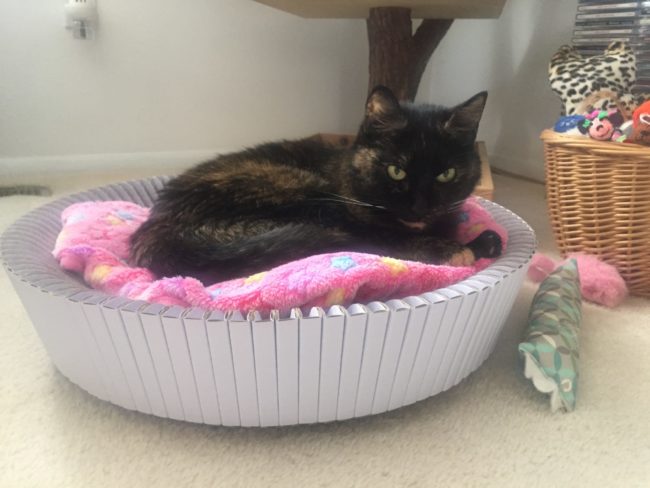
When she stopped wanting to be with me, it was like I was already losing a part of her. Once again, I wondered whether this was the beginning of the end, because some cats are known to isolate when they’re getting ready to die.
Thankfully, after a few days, she went back to her old pattern. She wanted to be on my lap again. She came to bed with me again and curled up in my arms as soon as I laid down. I was beyond grateful to get a little more cuddle time with my precious girl. I was never able to figure out why she stopped snuggling or sleeping with me for those few days.
Litter box issues
I always keep our litter boxes scrupulously clean. This became even more important now, as Ruby peed massive amounts several times a day.
She never stopped using the litter box, but she had a few episodes of incontinence in her sleep on my bed. I’m not sure I would have even noticed if it wasn’t for being woken up because all of a sudden, she’d sit up and start to clean herself in the middle of the night. Her urine at that point was so dilute, it barely smelled, and she only leaked a few drops of urine with each episode. These little accidents were easily cleaned up with my go-to pet stain remover, the Jackson Galaxy Stain and Odor Remover. However, I wanted to head off possible future issues, and I bought a waterproof mattress protector. Needless to say, I never once considered not letting her sleep with me. She only had a handful of these episodes, and after a week or two, they stopped completely.
Appearance
Ruby had always been meticulous about her appearance. Her coat was shiny, her eyes bright and sparkling. As her illness progressed, she didn’t groom herself as much as she used to, so I brushed her more frequently. She loved being brushed. I’m pretty sure it mattered to her to look as good as possible.
She began to have discharge from both eyes, most likely caused by a dormant herpes infection that her compromised immune system could no longer fight off. This was easily taken care of by gently wiping her eyes with a tissue moistened with warm water. It eventually progressed to nasal discharge, most likely caused by the same virus.
Seeing my pretty little girl look so scruffy and obviously ill was emotionally difficult for me. It was yet another sign of her rapid decline.
Holistic Therapies
Ruby received homeopathic remedies prescribed by Dr. Tasi. Dr. Tasi practices classical homeopathy. She is on the faculty of the Pitcairn Institute of Veterinary Homeopathy. Click here for a brief description of how homeopathy works if you want to learn more about it. Because of the nature of classical homeopathy, which considers the individual patient as a whole and takes symptoms from body, mind, and spirit into consideration when choosing a remedy, it doesn’t make sense for me to share which remedies Ruby received, because they wouldn’t apply to any other cat.
Ruby also received daily Reiki treatments from me, and I used the Assisi Therapy Pad and the Loop every day.
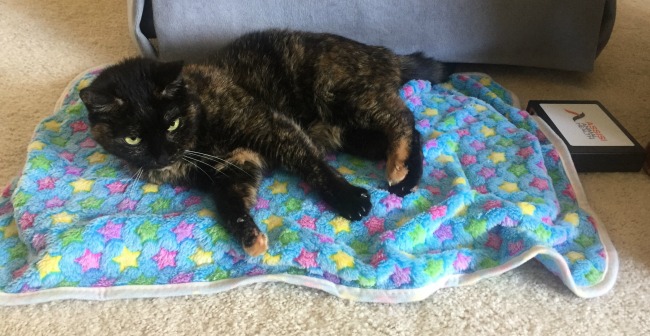
I received countless suggestions of medications, supplements and holistic remedies once I announced Ruby’s illness, and I appreciated that my readers cared enough to offer them. I was blessed to have a veterinarian I trusted completely in Dr. Tasi. Together, we explored all treatment options, both conventional and holistic, and we chose the ones that were best for Ruby.
Tanya’s Comprehensive Guide to Feline Chronic Kidney Disease
I didn’t spend a whole lot of time online researching kidney disease and kidney cancer, but one resource that was of great value to me during Ruby’s illness was Tanya’s Comprehensive Guide to Feline Chronic Kidney Disease. Don’t let the dated design of the site fool you: this site offers an incredible wealth of information on all aspects of caring for a cat with kidney disease. Even experienced cat parents will find useful information.
Taking Allegra’s needs into account
Hospice care is not just about the terminally ill patient, it also affects other members of the household. While I made sure Allegra got attention and affection, she often took second place during that time. Thankfully, Allegra has always been much more independent than Ruby. She remained in good spirits, but I would catch her occasionally watching Ruby with a concerned look on her face. I’m convinced that in her own way, Allegra quietly held the space for Ruby and me.
Some people, as well as some animals, are masters at holding the space. It means creating a quiet, safe, and peaceful environment. By being independent, yet loving, Allegra’s sweet energy allowed Ruby and me to cope with what was happening and to find our way through it with as much love and as little worry and fear as possible.
One of the things that never failed to boost my spirit during Ruby’s illness was to see the girls lounging together in my sunny bedroom.
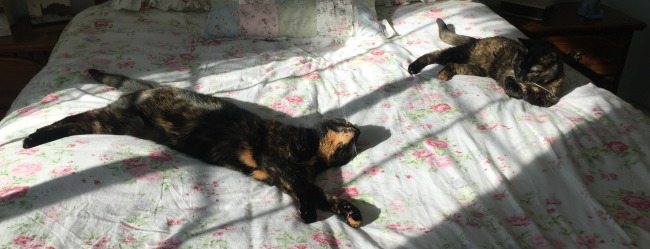
Coming next week:
Water, Water Everywhere: Hydration for Cats With Kidney Disease
*The Conscious Cat is a participant in the Amazon Services LLC Associates Program, an affiliate advertising program designed to provide a means for us to earn fees by linking to Amazon.com and affiliated sites. This means that if you decide to purchase through any of our links, we get a small commission. We only spread the word about products and services we’ve either used or would use ourselves.


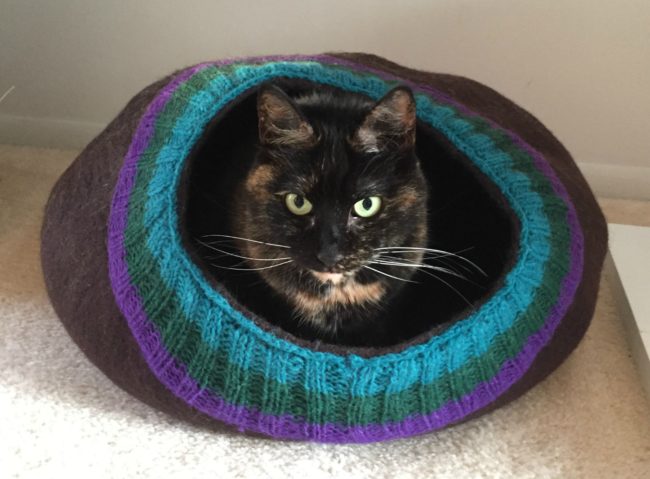
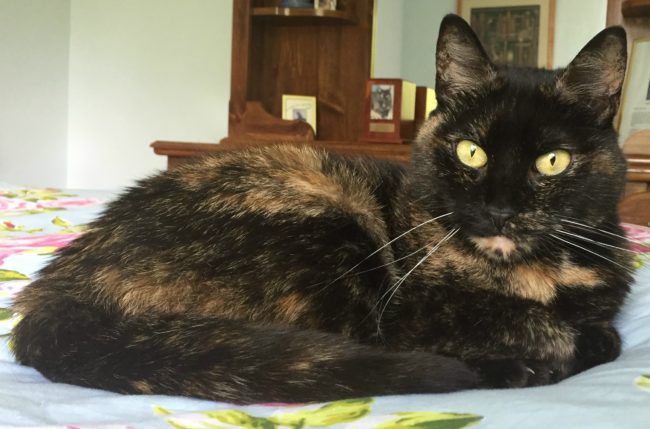
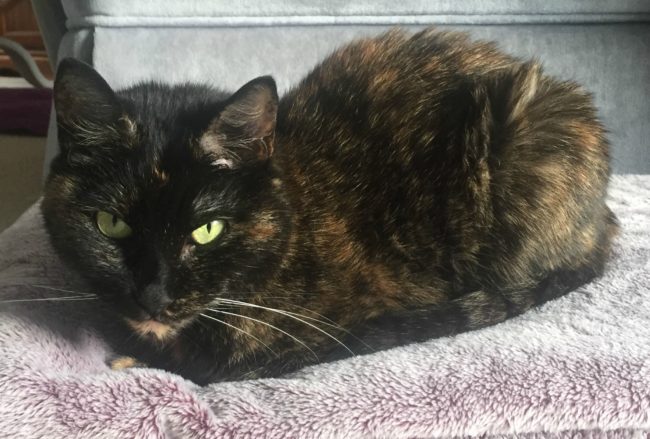
I had to put my beloved Cocoa to sleep two years ago last December. He was the perfect bedmate. I started sleeping on my back with my arm curled to my side. He would put his head on my upper arm and cuddle with me. When I moved to my side he would just go along. Sometimes he’d go under the covers and knead my stomach for a bit then go to sleep.
In August of 2018 he had seizures. My allopathic vet treated him with steroids. (Living on Long Island there is a dearth of holistic or homeopathic vets.) That night he had more seizures. Having holistic books on cat care I gave him Dr Bach’s Rescue Remedy which halted the seizures. However he started bleeding from his nose. My vet thought he might have a brain tumor. He did. I was able to contact a homeopathic veterinarian in Florida. With his help, my beautiful Cocoa lived happily until the last week of his life at the beginning of December. I had been giving him ringer’s solution three times a week on the homeopathic veterinarian’s advice which really helped. He was his old self until the last week of his life. The tumor grew so much that I had to put him to sleep on December 9, 2018. I still miss him very much as does his brother. Truly I’m grateful to have Nicky with me; I worried I wouldn’t in the beginning as Nicky went into a deep depression.
I feel great compassion for you on losing Ruby. Losing such a loving wonderful companion is very hard. I am glad you still have Allegra. I hope she’s as much comfort to you as my precious Nicky is to me.
Bless you, Ingrid.
I’m sorry about your Cocoa, Lynn. Thank you for sharing your experience, and for your kind words.
Good advice. I now have a third cat with kidney disease (the first two are gone now) and have found Tanya’s so very helpful I can’t recommend it highly enough. I echo your referral to it, Ingrid. Neither Boo nor MoMo got sick with the disease because I was able to stabilize them and keep phosphorus levels down with a binder. They both died of something else. My third is Bennie, my 16 yr old girl with hyperthyroidism. My vet thinks the kidney disease is so common with hyperT, it’s almost (or is?) inevitable. I haven’t been able, for about a year, to keep her weight up. I’m going to look at the Merrick kitten formula now. Lotsa cat food here!
Hi Ingrid- I am very much enjoying reading about your journey with Ruby. Thank you for sharing this. It helps a lot in coping with the death of my three cats who recently passed away from cancer and kidney failure. I can relate to your comment about landing on a food he (in this case Bobby) would like and feeling relieved when I found something he liked. I had virtually the same issues you did and could have also opened a cat food store. I definitely believe that in some way they are still with us and always will be.
Sending my love to you and Allegra!
Thank you for sharing that with us, we know it’s tough, it always is.
Seeing posts like this are so important and I am glad you have chosen to do it. Unfortunately, death has become far removed for so many (whether human or animal) and palliative care is forgotten.
We lost two cats this year.. one my ‘baby’ the other my husbands ‘baby’ We have 3 remaining. One of the three left was quite bonded to Ozzy who passed at the ripe age of 21, Minnie struggles every day and has lost weight too. She is eating but barely she gets whatever she wants to eat now.
It is difficult some days but every day is a joy to have them.
You have my total sympathy. A week ago I lost my 21 year old Nina. We got her at 8 weeks old. She was my daughter. She got a malignant tumor under her tongue and it quickly escalated to the point where she couldn’t eat. She was literally going to starve to death, so of course we did the kindest thing. I’m crying as I write this. Such a cruel cancer.
We lost our kidney cat 2.5 years ago. I have bookmarked the web site in your post for the future in case. It has so much information. Unfortunately I will probably need it at some time as CKD is quite common and we have 7 cats. Thank you.
I love how you defined hospice care. So often people think hospice is just about dying, but it’s so much more. It’s also allowing the being we love to leave this world with some dignity.
Not looking forward to the time I have to make these decisions as well but I will do my best to always consider what is best for my baby and not my needs. Article is a great reminder on how best to do that.
Lovely Ruby. You are such a good cat Mom.
INGRED THAT BOOK YOU MENTIONED WAS SO INFORMATIVE. BLESS YOU.
Thank you for sharing your insight with us. I know how hard it is for you to write about Ruby’s final days. She was blessed to have someone with your love and knowledge caring for her.
I know these posts must be so hard for you do, but thank you for posting such helpful and needed advice.
So sad but I am glad you got to spend the usual cuddles and hugs with Ruby. And Allegra is so sweet to give you two space and that concern looks. Bless her ❤
Thank you so much for this. I work in palliative care for adults and it is so important. My beautiful Elwood died from chronic kidney disease in January last year. I went to the vet today to arrange boarding for a couple of days and they asked “for the 5 of them?” I had a stunned moment and she realised, there are only 4. It gets easier but you always miss your beloved friends/family members/dare I say children.
Thank you again for sharing Ruby with all of us
xxx